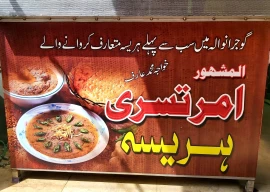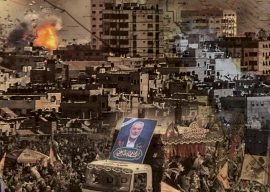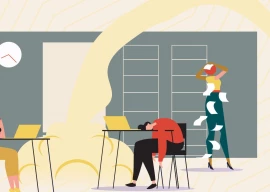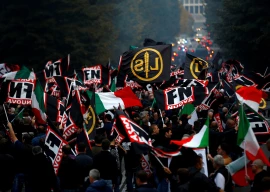

A tweet by Channel 4 anchor, Jon Snow that incorrectly identified a Syrian child as a Gaza victim. He later apologised for it. PhOTO COURTESY TWITTER AND INSTAGRAM
Social media has turned everyone into a stakeholder in events that are taking place thousands of miles away. The fact that most of us are now completely in sync and vested in events that occur in parts of the world that we previously had little familiarity or access to is perhaps the biggest testimony to its power. And this power can be a game changer, depending on how it is utilised.
The revolution shall be tweeted?
One of the most recent events that took social media by storm was the launch of Operation Protective Edge by Israel in July this year. According to the Gaza Ministry of Health, the operation claimed 1,951 Palestinian lives over a period of seven weeks. The Israel army website and agencies on the other hand show the loss of 67 lives on their side. Globally, the operation was seen as a one-sided display of brute power by the Israeli Defence Forces and led to a backlash against their actions. On the other hand, there was an outpour of support and sympathy for the residents of Gaza, who were seen as victims of the conflict.

Globally, there was a flood of tweets in support of Gaza during Operation Protective Edge. PhOTO COURTESY TWITTER AND INSTAGRAM
While this contrast in public opinion was hard to gauge on traditional media outlets — most of which either portrayed the conflict as a clash between two equal forces or used Hamas to justify Israeli attacks on the civilian population — the stance was much clearer on social media. Users from all across the world condemned Israel’s inhuman actions and pleaded to international bodies to intervene and provide protection to the Palestinians. According to Al Jazeera, the hashtag #GazaUnderAttack was used four million times during this period whereas the hashtag #IsraelUnderFire was used only 200,000 times.
Renowned celebrities such as actors John Cusack, Mia Farrow, Kerry Washington and Rob Schneider along with Zayn Malik, a member of the boy band One Direction, also expressed their support openly in favour of the Palestinians. The pro-Israeli camp also had its share of popular names such as reality TV star Simon Cowell, TV and radio host Howard Stern, actor Mark Pellegrino and NBA player Omri Casspi, supporting their stance on social media. Several musicians such as The Backstreet Boys and Megadeth and hip-hop star CeeLo Green cancelled their concerts in Tel Aviv. While various reasons were cited for these cancellations, The Daily Star credited pro-Palestinian groups who used social media campaigns to “urge performers to boycott the Jewish state.”

The hashtag #BringBackOurGirls picked up momentum when renowned personalities such as Michelle Obama came on board. PHOTO COURTESY TWITTER AND INSTAGRAM
“These types of conflicts have a tendency to cluster in ‘party lines’,” said Dr Nir T Boms, a research fellow at Tel Aviv University and the co-founder of a network of bloggers from The Middle East, during an online interview. He added that this conflict between Palestinians and Israelis is often framed as a clash between Muslims and Jews. “Hence, we may find at least some natural sympathisers among the immediate ‘kinsman’ of these two groups which are not of equal size (There are about 1.3 billion Muslims in the world and only 14 million Jews),” he says in an attempt to explain the wide discrepancy in online support between the two sides.
On the other hand, Yahya Lababidi, an Egyptian author with Palestinian roots, labelled the role of social media “indispensable” as it enables people to learn, unite and protest. “Even thousands of Israel’s [voices] cannot compete with the terrible truths of dying children and the irrefutable images of death and destruction in Gaza,” he said. “Or the apocalyptic visions of destruction of homes, schools and villages. Or the heartrending reality of hundreds of thousands [of people] displaced without a home because of this carnage.”

Pakistani child activist also uses social media to express her opinion on global issues frequently. PHOTO COURTESY TWITTER AND INSTAGRAM
Even though Twitter had played an important role during the eight-day Operation Pillar on Defense in 2012 as well when IDF forces had attacked the Gaza strip, its intensity was far greater this time. Even the two warring factions, IDF and Hamas, posted updates, tweets and videos in an attempt to win hearts and minds.

This picture that made rounds on social media incorrectly identified this girl as Nigerian. Her tears were also photoshopped. PHOTO COURTESY TWITTER AND INSTAGRAM
The impact of social media has not just been limited to the Gaza conflict. Previously, the protests that broke out all across the Muslim world from 2010 to 2012 were also widely documented on Facebook, Twitter, YouTube and Instagram. The death and destruction that has ravaged Syria for the past three years also made its way to eyes and ears across the world due to these platforms. The plight of the 276 schoolgirls that were kidnapped by Boko Haram in Nigeria also picked up momentum through social media. Despite attempts by the government to control information, images, tweets and videos coming out of Hong Kong these days has given the world an insight into the country’s struggle for democracy. In Pakistan, tweets and Facebook videos have been used as evidence against the alleged rigging of the 2013 elections and to solicit support in favour of and against political parties.
Not all news is good news
Any powerful tool, if used excessively or without checks and balances, has the potential to backfire. Social media is no exception. While it has filled up the information gaps that may be overlooked (consciously or otherwise) by traditional media outlets and made it impossible for those in power to control or distort news to serve their agendas, it can also lead to misinformation, panic and hatemongering.

A snap shot of Instagram posts expressing solidarity with the people of Gaza. PHOTO COURTESY TWITTER AND INSTAGRAM
The speed at which information is transmitted in the virtual world often makes it difficult to distinguish between facts and speculation. For example, an image of a girl with tears in her eyes that was circulated widely on social media during the ‘Bring Back Our Girls’ campaign eventually turned out to be fake. The girl in the picture was not from Nigeria and her tears were photoshopped. By the time this loophole was pointed out, celebrities such as Chris Brown, Kim Kardashian and even the US embassy in Madrid had already shared the image. Similarly, pictures of Syrian war victims were also circulated widely on social media, captioned as victims of Israeli violence. Jon Snow, an anchor on Channel 4, also tweeted the picture of a Syrian child mistaking him for a child in Gaza and apologised for the error later.

A snap shot of Instagram posts expressing support for Israel. PHOTO COURTESY TWITTER AND INSTAGRAM
Moreover, critical details such as the context, history and implications etcetera are often lost when a news item is shrunk into 140 characters or a single image. The conversation is also usually dominated by extreme narratives and often ends up drowning out the balanced moderate voices. Unequal access to technology also skews the discourse in favour of those with access to gadgets and smartphones and isolates those who do not have access to these resources.
Apart from inaccuracy, the aggressive use of social media in certain cases, such as the Boko Haram, the Taliban and recently the ISIS, has also been criticised for glorifying the enemy by giving them more attention than they deserve. In certain cases, it has also been dismissed as armchair activism — something that has little impact in real-life situations.
The devil is in the details
“The flood of information has transformed conflict zones from areas once dominated by the ‘fog of war’ to regions of information surplus,” wrote Anand Varghese, a programme specialist at United States Institute of Peace’s (USIP) Center, of Innovation for Science, Technology and Peacebuilding, in his publication Preparing for Peace: Communications in Conflict Resolution. Hence, there is a need for rules and guidelines to prevent ourselves from getting trapped in predictable loopholes.

Pop queen Madonna also posted a picture on Instagram with a message of peace and humanity. PHOTO COURTESY TWITTER AND INSTAGRAM
Syria’s Socially Mediated Civil War — a 2014 report by the USIP which assessed the social media content emerging from Syria, its credibility and how it travels — revealed that apart from verification of sources and filtering out facts from noise, it is also critical to connect online trends to real-world developments. It states that experts need to account for inherent structural biases and devise mechanisms that look at people’s broader political affiliations, backgrounds and sentiments when deducing trends based on virtual activities. It concludes that implementation of these sophisticated research mechanisms are still a work in progress. Until these systems are put into place, social media should always be used to get a clearer insight into issues/events keeping in mind that it may not be always be the complete picture. Or the only picture.
How social media can indicate general public opinion
Number of times the hashtag
#IsraelUnderFire was used on Twitter: 200,000
Number of times the hashtag
#GazaUnderAttack was used on Twitter: 4 million or 4,000,000
Number of Instagram posts for
#GazaUnderAttack: 218,021
Number of Instagram posts for
#IsraelUnderAttack: 8,958
A few global issues/conflicts that created an uproar on social media
KONY2012:
A short film that was produced to have African militia leader and war criminal Joseph Kony arrested by the end of 2012. The film spread through the #Kony2012 hashtag.
YESALL’WOMEN:
A Twitter hashtag and social media campaign, which encouraged users to share examples or stories of misogyny and violence against women.
ISIS:
The extremist Islamic State group which has displayed immense sophistication in their use of social media. Its critics, however, have also launched social media campaigns such as the #BurnISISFlagChallenge to counter the organisation’s violent propaganda.

An Instagram post showing support for Gaza. PHOTO COURTESY TWITTER AND INSTAGRAM
How social media can be used to play a positive role during conflict
Fostering inter-ethnic dialogue: Social media can be used to bridge divides between adversaries, especially youth. For example, the Salam Shabab online youth network in Iraq, which shows shifting attitudes about ethnic diversity and the 200,000-member YaLa-Young Leaders network in the Middle East, which promotes communication between Israelis and Palestinians.
Managing elections: Voting was actively monitored in places like Kenya and Sudan for everything from violence to fraud using a range of social media platforms.
Preventing gang violence: Twitter penetration in Brazil is among the highest on the planet, and communities in Brazilian favelas, or shantytowns, say it has been a game-changer in helping bring down both gang and police violence.

Preventing resource disputes: Early-warning networks like CEWARN in sub-Saharan Africa are being set up to leverage social media, along with other forms of satellite information and traditional media reports, to prevent conflict over land, water and other resources.
Constitution-building: Places such as Egypt have attempted to build constitutions with public input through social media. Even though it wasn’t very successful there, the initiative has great potential.

Protesting violence: In 2008, Oscar Morales, a young Colombian engineer, used Facebook to rally people all across Colombia against the violent tactics of the guerrilla group commonly known as the FARC in 2008. It marked the beginning of a trend in the use of social networks to bring people together to protest against violence.
Published in The Express Tribune, Sunday Magazine, October 12th, 2014.


















COMMENTS
Comments are moderated and generally will be posted if they are on-topic and not abusive.
For more information, please see our Comments FAQ